
The River Severn, at 220 miles (354 km) long, is the longest river in Great Britain. It is also the river with the most voluminous flow of water by far in all of England and Wales, with an average flow rate of 107 m3/s (3,800 cu ft/s) at Apperley, Gloucestershire. It rises in the Cambrian Mountains in mid Wales, at an altitude of 2,001 feet (610 m), on the Plynlimon massif, which lies close to the Ceredigion/Powys border near Llanidloes. The river then flows through Shropshire, Worcestershire and Gloucestershire. The county towns of Shrewsbury, Worcester and Gloucester lie on its course.
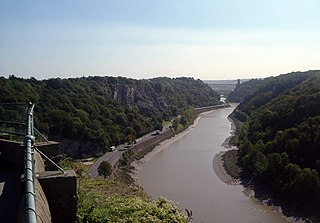
The River Avon is a river in the southwest of England. To distinguish it from a number of other rivers of the same name, it is often called the Bristol Avon. The name 'Avon' is loaned from an ancestor of the Welsh word afon, meaning 'river'.

A steamboat is a boat that is propelled primarily by steam power, typically driving propellers or paddlewheels. Steamboats sometimes use the prefix designation SS, S.S. or S/S or PS ; however, these designations are most often used for steamships.

The canal network of the United Kingdom played a vital role in the Industrial Revolution. The UK was the first country to develop a nationwide canal network which, at its peak, expanded to nearly 4,000 miles in length. The canals allowed raw materials to be transported to a place of manufacture, and finished goods to be transported to consumers, more quickly and cheaply than by a land based route. The canal network was extensive and included feats of civil engineering such as the Anderton Boat Lift, the Manchester Ship Canal, the Worsley Navigable Levels and the Pontcysyllte Aqueduct.

A paddle steamer is a steamship or steamboat powered by a steam engine driving paddle wheels to propel the craft through the water. In antiquity, paddle wheelers followed the development of poles, oars and sails, whereby the first uses were wheelers driven by animals or humans.

A horse-drawn boat or tow-boat is a historic boat operating on a canal, pulled by a horse walking beside the canal on a towpath.

The canals of the United Kingdom are a major part of the network of inland waterways in the United Kingdom. They have a varied history, from use for irrigation and transport, through becoming the focus of the Industrial Revolution, to today's role of recreational boating. Despite a period of abandonment, today the canal system in the United Kingdom is again increasing in use, with abandoned and derelict canals being reopened, and the construction of some new routes. Canals in England and Wales are maintained by navigation authorities. The biggest navigation authorities are the Canal & River Trust and the Environment Agency, but other canals are managed by companies, local authorities or charitable trusts.

Bristol Harbour is the harbour in the city of Bristol, England. The harbour covers an area of 70 acres. It is the former natural tidal river Avon through the city but was made into its current form in 1809 when the tide was prevented from going out permanently. A tidal by-pass was dug for 2 miles through the fields of Bedminster for the river, known as the "River Avon New Cut", "New Cut", or simply "The Cut". It is often called the Floating Harbour as the water level remains constant and it is not affected by the state of the tide on the river in the Avon Gorge, The New Cut or the natural river southeast of Temple Meads to its source.
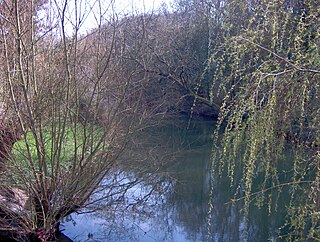
The Frome, historically the Froom, is a river that rises in Dodington Park, South Gloucestershire and flows southwesterly through Bristol to join the river Avon. It is approximately 20 miles (32 km) long, and the mean flow at Frenchay is 60 cubic feet per second (1.7 m3/s). The name Frome is shared with several other rivers in South West England and means 'fair, fine, brisk'. The river is known locally in east Bristol as the Danny.
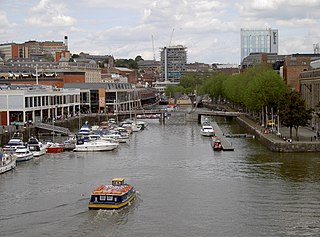
Bristol Ferry Boats is a brand of water bus services operating around Bristol Harbour in the centre of the English city of Bristol, using a fleet of distinctive yellow-and-blue painted ferry boats. The services were formerly owned by the Bristol Ferry Boat Company, but are now the responsibility of Bristol Community Ferry Boats, a community interest company that acquired the fleet of the previous company.

Belle of Louisville is a steamboat owned and operated by the city of Louisville, Kentucky, and moored at its downtown wharf next to the Riverfront Plaza/Belvedere during its annual operational period. The steamboat claims itself the "most widely traveled river steamboat in American history." Belle of Louisville's offices are aboard Mayor Andrew Broaddus, and also appears on the list of National Historic Landmarks.
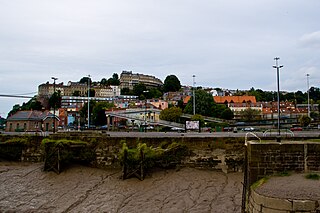
Hotwells is a neighbourhood in the English port city of Bristol. It is located to the south of and below the high ground of Clifton, and directly to the north of the Floating Harbour. The southern entrance to the Avon Gorge, which connects the docks to the sea, lies at the western end of Hotwells. The eastern end of the area is at the roundabout where Jacobs Well Road meets Hotwell Road. Hotwells is split between the city wards of Clifton, and Hotwells and Harbourside.
The majority of public transport users in the Bristol Urban Area are transported by bus, although rail has experienced growth and does play an important part, particularly in peak hours.

Netham Lock is the point at Netham in Bristol at which boats from the River Avon, acting as part of the Kennet and Avon Canal, gain access to Bristol's Floating Harbour.
The Bristol Classic Boat Company is a boat building and restoration company based at Bristol's Floating Harbour, England.

SS Ste. Claire is a steamer located in Detroit, Michigan. Built in 1910, she was one of the last propeller-driven excursion steamers to be operated on the Great Lakes. She was declared a US National Historic Landmark in 1992. In 2018, a devastating fire destroyed the upper decks, leaving only the steel structure. The ship was delisted as a National Historic Landmark and from the National Register of Historic Places in 2023.
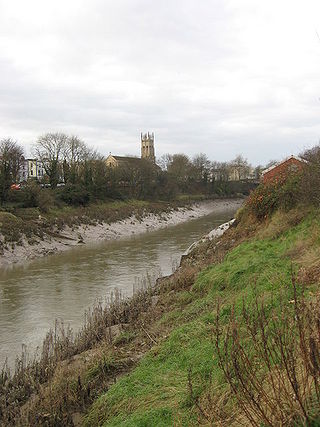
The New Cut is an artificial waterway which was constructed between 1804 and 1809 to divert the tidal river Avon through south and east Bristol, England. This was part of the process of constructing Bristol's Floating Harbour, under the supervision of engineer William Jessop. The cut runs from Totterdown Basin at the eastern end of St Phillip's Marsh, near Temple Meads, to the Underfall sluices at Rownham in Hotwells and rejoining the original course of the tidal Avon.

A tour boat is a boat used, and frequently purpose-built or adapted, for boat tours, a type of tourism frequently offered in much visited towns and cities of historic interest, that have canals or a river running through it, or that lie on a coast or a lake.
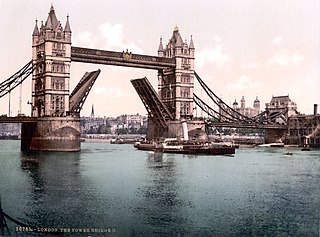
Steamboat services started on the Thames in around 1815 and for nearly 25 years were the main use of steam to carry passengers before the emergence of railways in the south of England. During this time at least 80 steamers are recorded in the Thames and the Steamboat Act of 1819 became the first statute to regulate the safety of the new technology for the public. Wooden boats driven by paddle-wheels, they managed during this time to establish themselves as faster and more reliable than the earlier use of sailing and rowing boats for passenger transport within the Thames estuary.

Tower Belle is a passenger boat based in Bristol Harbour in England. The vessel is operated by the Bristol Packet Boat Trips company on pleasure and educational trips in the City Docks, on the River Avon to the Chequers Inn at Hanham Lock and Beese's Tea Gardens at Conham. Tower Belle was built in 1920 in Newcastle upon Tyne by Armstrong Whitworth, originally known as Wincomblee. In the 1950s and 1960s she worked in London, finally coming to Bristol in 1976.




















